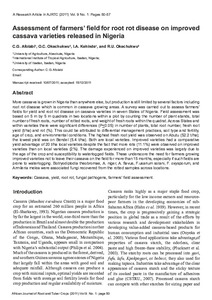| dc.contributor.author | Afolabi, C.G. |
| dc.contributor.author | Okechukwu, O.C. |
| dc.contributor.author | Kehinde, I.A. |
| dc.contributor.author | Okechukwu, R.U. |
| dc.date.accessioned | 2019-12-04T11:10:40Z |
| dc.date.available | 2019-12-04T11:10:40Z |
| dc.date.issued | 2011 |
| dc.identifier.citation | Afolabi, C.G., Okechukwu, O.C., Kehinde, I.A. & Okechukwu, R.U. (2011). Assessment of farmers’ field for root rot disease on improved cassava varieties released in Nigeria. Africa Journal of Root and Tuber Crops, 9(1), 50-57. |
| dc.identifier.issn | 1118-2075 |
| dc.identifier.uri | https://hdl.handle.net/20.500.12478/2230 |
| dc.description.abstract | More cassava is grown in Nigeria than anywhere else, but production is still limited by several factors including root rot disease which is common in cassava growing areas. A survey was carried out to assess farmers’ fields for yield and root rot disease on cassava varieties in seven States of Nigeria. Field assessment was based on 5 m by 5 m quadrats in two locations within a plot by counting the number of plant stands, total number of fresh roots, number of rotted roots, and weight of fresh roots within the quadrat. Across States and within varieties there were signiicant differences (P<0.05) in number of plants, total root number, fresh root yield (t/ha) and rot (%). This could be attributed to differential management practices, soil type and fertility, age of crop, and environmental conditions. The highest fresh root yield was observed on Abutu (52.2 t/ha); the lowest yield was on Bendel (5.4 t/ha). Both are local varieties. Improved varieties had a comparative yield advantage of 20 t/ha local varieties despite the fact that more rots (11.1%) were observed on improved varieties than on local varieties (2%). The damage experienced on improved varieties was largely due to the age of the crop and susceptibility to waterlogged ields. These underscore the need for farmers growing improved varieties not to leave their cassava on the ield for more than 15 months, especially if such ields are prone to waterlogging. Botryodiplodia theobromae, A. niger, A. lavus, F.usarium solani, F. oxysporum, and Armileria melea were associated fungi recovered from the rotted samples across locations. |
| dc.language.iso | en |
| dc.subject | Cassava |
| dc.subject | Yield |
| dc.subject | Root Rots |
| dc.subject | Pathogens |
| dc.subject | Assessment |
| dc.subject | Farmers |
| dc.title | Assessment of farmers' field for root rot disease on improved cassava varieties released in Nigeria |
| dc.type | Journal Article |
| dc.description.version | Peer Review |
| cg.contributor.affiliation | University of Agriculture, Abeokuta |
| cg.contributor.affiliation | International Institute of Tropical Agriculture |
| cg.contributor.affiliation | University of Ibadan |
| cg.coverage.region | Africa |
| cg.coverage.region | West Africa |
| cg.coverage.region | West And Central Africa |
| cg.coverage.region | East Africa |
| cg.coverage.region | Southern Africa |
| cg.coverage.country | Nigeria |
| cg.coverage.country | Ghana |
| cg.coverage.country | Congo, Dr |
| cg.coverage.country | Madagascar |
| cg.coverage.country | Mozambique |
| cg.coverage.country | Tanzania |
| cg.coverage.country | Uganda |
| cg.authorship.types | CGIAR and developing country institute |
| cg.iitasubject | Cassava |
| cg.iitasubject | Disease Control |
| cg.journal | African Journal of Root and Tuber Crops |
| cg.howpublished | Formally Published |
| cg.accessibilitystatus | Limited Access |
| local.dspaceid | 90961 |

